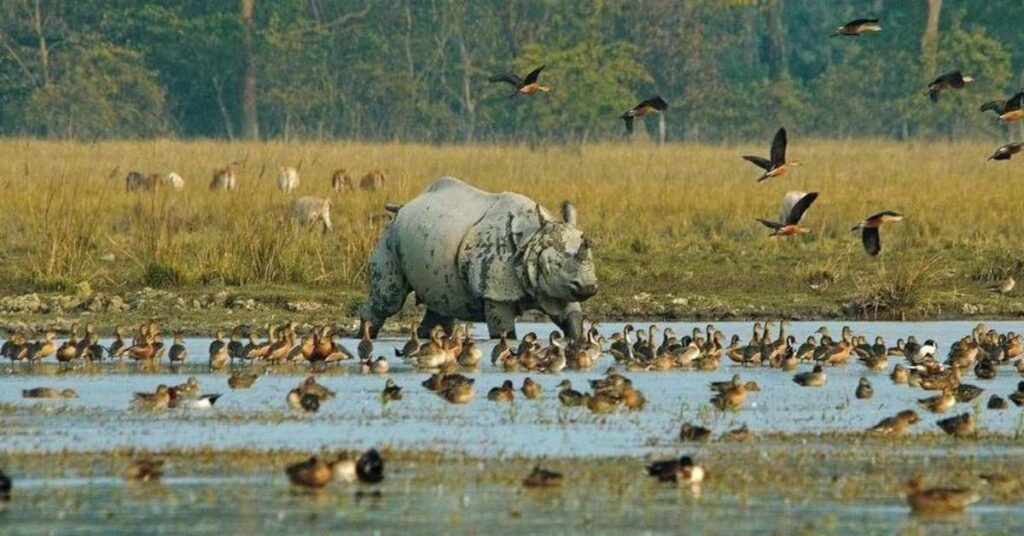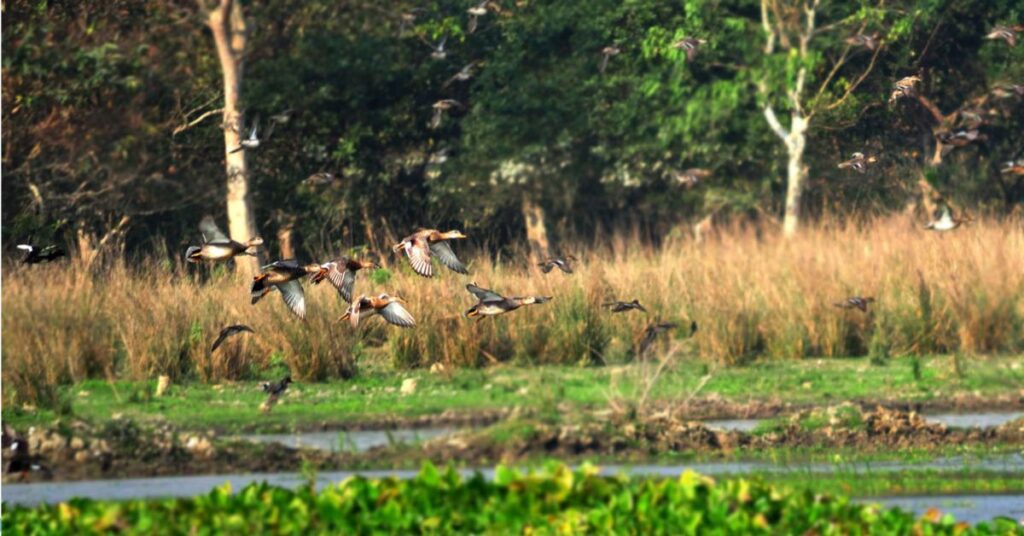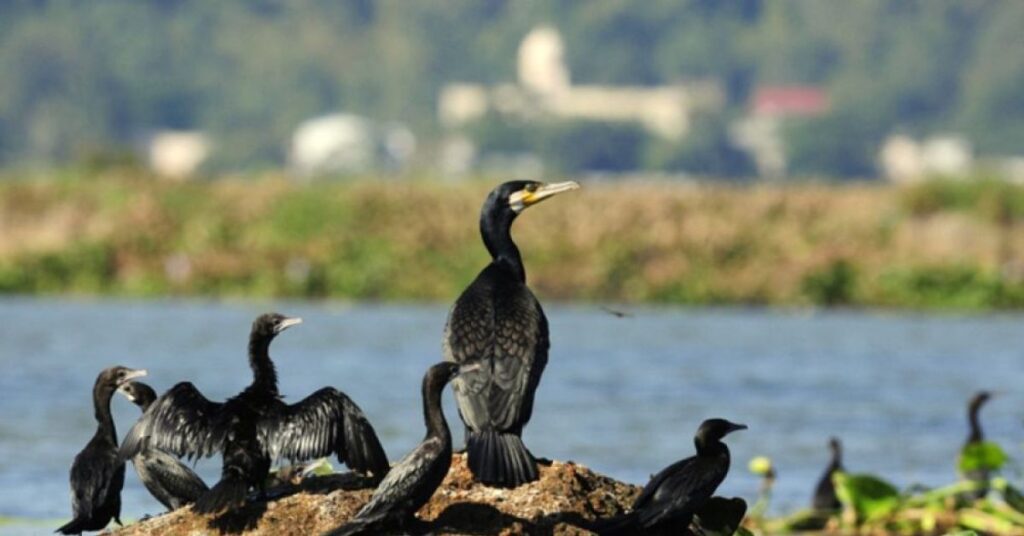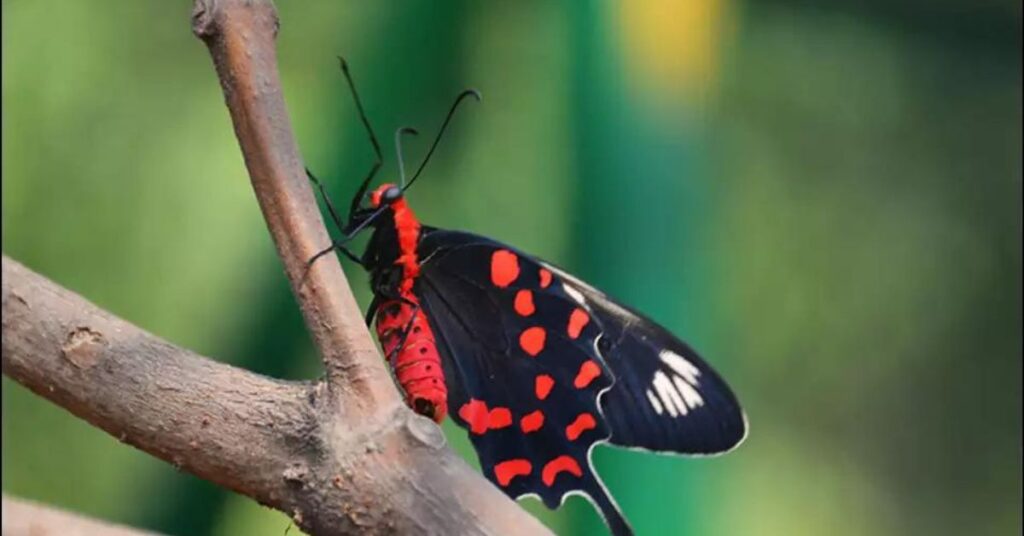Nestled amidst the heart of Assam, Ambari Wildlife Sanctuary is a verdant paradise teeming with life. A haven for nature enthusiasts, the sanctuary offers a captivating glimpse into the raw beauty and rich biodiversity of the region. Lush forests, home to a vibrant array of avian wonders, intertwine with tranquil waterways that harbor diverse aquatic life. Whether you’re an avid birdwatcher seeking rare species or a wildlife photographer capturing nature’s essence, Ambari promises an unforgettable journey. Immerse yourself in the sanctuary’s serene ambiance as you explore its hidden corners, each revealing new treasures and celebrating the magnificence of the natural world.
How to reach:
By Air
The closest airport to Ambari Wildlife Sanctuary is Lokpriya Gopinath Bordoloi International Airport in Guwahati, situated approximately 150 kilometers away. This major airport offers connections to various cities within India. From Guwahati, you can hire a taxi or board a bus to reach the sanctuary.
By Train
Guwahati Railway Station, the nearest railhead to Ambari Wildlife Sanctuary, provides excellent connectivity to different parts of the country. Once you arrive in Guwahati, you can either hire a taxi or take a bus to reach the sanctuary, which is a journey of about 3-4 hours.
By Road
Ambari Wildlife Sanctuary is accessible by road through several routes:
- From Guwahati: You can hire a taxi or opt for a state-run or private bus service to cover the 150 kilometers to the sanctuary. The journey typically takes 3-4 hours.
- From Jorhat: Taxis or buses are available for the approximately 230-kilometer journey from Jorhat to Ambari. The travel time is around 5-6 hours.
- Self-Drive: For those who prefer driving, National Highway 27 (NH27) and connecting roads lead to the sanctuary. The roads are generally well-maintained.
Local Transport
Once you reach Ambari Wildlife Sanctuary, you can explore the area using local transportation options like rickshaws, taxis, or guided tours provided by the sanctuary authorities. It’s advisable to inquire about the best transportation options within the sanctuary at the sanctuary office or from local guides.
Best time to visit:
Winter (November to February)
Winter brings pleasant, cool weather to Ambari Wildlife Sanctuary, making it ideal for outdoor activities and wildlife spotting. Animals are more active during this dry season, and water sources become wildlife hotspots. This is the peak time for birdwatching as migratory birds grace the sanctuary. Pack warm clothing for early mornings and evenings.
Summer (March to May)
Temperatures rise in summer, but the sanctuary remains explorable. Wildlife congregates near water bodies, increasing spotting chances. Early morning and late afternoon safaris are recommended to beat the midday heat. Light, breathable clothing and sun protection are essential.
Monsoon (June to October)
Heavy rainfall transforms the sanctuary into a lush green paradise. However, dense foliage makes wildlife sightings challenging and some areas become inaccessible. While not peak season, monsoon offers a serene experience for those who enjoy the rain-drenched forests. Waterproof clothing and footwear are must-haves, and be prepared for potential travel disruptions.
Attractions:
Diverse Wildlife:

Ambari Wildlife Sanctuary is a treasure trove of biodiversity, teeming with an incredible array of wildlife. Majestic elephants roam freely through the lush forests, sharing their habitat with elusive leopards and nimble deer. The sanctuary is also home to a vibrant primate population, including the playful capped langurs and the enigmatic hoolock gibbons. Birdwatchers will be enchanted by the over 200 bird species, from the striking Indian pied hornbill to the rare white-winged wood duck. Winter transforms the sanctuary into a birdwatcher’s paradise as migratory birds flock to the area, creating a spectacular avian spectacle.
Bird Watching:

Ambari Wildlife Sanctuary is a birdwatcher’s paradise. Home to over 200 different bird species, both resident and migratory, the sanctuary offers an incredible opportunity to spot a diverse array of feathered friends. From the vast wetlands to the dense forests, every habitat teems with avian life. Keep an eye out for rare and captivating birds like the majestic great hornbill or the enigmatic Indian eagle-owl. Guided birdwatching tours provide expert insights, enhancing your experience and chances of spotting these elusive creatures.
Aquatic Life and Water Bodies:

Ambari Wildlife Sanctuary is home to a network of pristine rivers, streams, and lakes that form the heart of its ecosystem. These water bodies teem with life, supporting a rich diversity of fish, amphibians, and turtles. Visitors can enjoy peaceful boat rides or leisurely walks along the banks, where they can observe the vibrant aquatic life and the many bird species that depend on these waters. These water bodies also serve as vital watering holes for the sanctuary’s wildlife, offering excellent opportunities for wildlife photography and observation. Whether you explore by boat or on foot, the serene beauty of these aquatic habitats provides a tranquil escape into the heart of the sanctuary.
Butterfly Watching:

Ambari Wildlife Sanctuary is a haven for butterfly enthusiasts, with its diverse habitats supporting a vibrant population of butterflies. The sanctuary’s varied flora provides essential nectar sources and breeding grounds for numerous butterfly species, making it an ideal destination for butterfly watching and photography. Visitors can spot colorful butterflies fluttering among wildflowers and sunlit clearings, adding a splash of color to the sanctuary’s natural surroundings. Guided butterfly walks offer insights into butterfly behavior, lifecycle stages, and their ecological role within the ecosystem. Whether capturing close-up shots of rare species or simply enjoying the sight of butterflies in flight, the sanctuary provides a tranquil setting for appreciating these delicate yet captivating creatures.
Local Experiences:
Elephant Safaris: Embark on a thrilling elephant safari guided by experienced mahouts, offering a unique perspective of the sanctuary.Birdwatching: Spot over 200 bird species, including migratory visitors, in the sanctuary’s diverse habitats.
Nature Trails: Explore the sanctuary’s flora and fauna up close on guided nature trails with expert naturalists.
Cultural Immersion: Interact with local Bodo and Karbi tribes to experience their rich traditions and lifestyle.
Butterfly Watching: Marvel at the vibrant colors of butterflies amidst blooming wildflowers.
Cultural Performances: Immerse yourself in Assam’s rich culture through traditional music, dance, and folk performances.
Boat Safaris: Enjoy peaceful boat rides on the sanctuary’s water bodies, perfect for spotting aquatic life and birds.
Educational Experiences: Participate in workshops and learn about wildlife conservation and sustainable practices.
Photography: Capture stunning wildlife and landscapes with ample opportunities for photography enthusiasts.
Culinary Delights: Savor the flavors of Assam with traditional local cuisine at nearby eateries or during cultural events.
Travel tips:
Research: Learn about the sanctuary’s attractions, wildlife, and best time to visit.
Best Season: Plan your trip during the winter (November to February) for pleasant weather and better wildlife sightings.
Permits and Fees: Check for required permits and entry fees beforehand.
Packing: Pack light, breathable clothing suitable for the season. Carry warm layers for winter visits. Wear comfortable walking shoes.
Essentials: Bring binoculars for birdwatching, a camera with a zoom lens, sufficient water, and sun protection.
Wildlife Etiquette: Maintain a safe distance from wildlife and follow sanctuary guidelines.
Health and Safety: Carry a basic medical kit and stay hydrated, especially during outdoor activities.
Cultural Respect: Respect local customs and traditions, particularly when interacting with tribal communities.
Environmental Responsibility: Protect the environment by avoiding litter, respecting wildlife habitats, and supporting eco-friendly practices.
Conclusion
Ambari Wildlife Sanctuary in Assam is a captivating haven where nature, culture, and tranquility converge. Explore dense forests on thrilling elephant safaris, marvel at the vibrant avian world, and immerse yourself in the rich traditions of local tribal communities. From serene boat rides on picturesque waterways to enlightening workshops on wildlife conservation, Ambari offers a holistic experience that educates, inspires, and rejuvenates. As you depart with cherished memories of wildlife encounters and the warm hospitality of Assam, you’ll gain a profound appreciation for the delicate balance between humans and nature. Ambari Wildlife Sanctuary is not just a sanctuary for animals, but also a sanctuary for the soul, inspiring us to prioritize conservation and sustainable tourism. Discover more about planning your unforgettable journey at Xplro.com.
FAQs
Where is Ambari Wildlife Sanctuary located?
- Ambari Wildlife Sanctuary is situated in the Golaghat district of Assam, India, near the town of Golaghat.
What is the best time to visit Ambari Wildlife Sanctuary?
- The best time to visit is from November to February during the winter months when the weather is pleasant and wildlife sightings are optimal.
How can I reach Ambari Wildlife Sanctuary?
- To reach the sanctuary, you can fly to Lokpriya Gopinath Bordoloi International Airport in Guwahati and then travel by road. Alternatively, you can take a train to Guwahati Railway Station and continue by taxi or bus to the sanctuary.
What are the entry timings and fees for Ambari Wildlife Sanctuary?
- The sanctuary is typically open from [specific timings]. Entry fees are [fee details].
What are the main attractions at Ambari Wildlife Sanctuary?
- Key attractions include diverse wildlife such as Indian elephants, leopards, and numerous bird species. Visitors also enjoy nature trails, elephant safaris, and cultural experiences with local tribes.
Are there accommodation options near Ambari Wildlife Sanctuary?
- Yes, there are various accommodation options including guesthouses and resorts near the sanctuary. It’s advisable to book in advance, especially during peak seasons.
Can I take a guided tour of Ambari Wildlife Sanctuary?
- Yes, guided tours led by experienced naturalists are available. These tours provide insights into the sanctuary’s flora, fauna, and conservation efforts.
What should I pack for a visit to Ambari Wildlife Sanctuary?
- Pack lightweight and breathable clothing suitable for the season, comfortable walking shoes, binoculars for bird watching, a camera with a zoom lens for photography, sunscreen, and insect repellent.
Is it safe to visit Ambari Wildlife Sanctuary?
- Yes, it is generally safe to visit. However, visitors should follow sanctuary guidelines, maintain a safe distance from wildlife, and respect local customs.
Are there cultural experiences available at Ambari Wildlife Sanctuary?
- Yes, visitors can experience the culture of local tribal communities through village visits, traditional performances, and interactions with tribal artisans.
What activities can I participate in at Ambari Wildlife Sanctuary?
- Activities include elephant safaris, bird watching, nature trails, photography, boat rides, and educational workshops on wildlife conservation.
How can I contribute to conservation efforts at Ambari Wildlife Sanctuary?
- Visitors can contribute by practicing responsible tourism, respecting wildlife and their habitats, participating in educational programs, and supporting local conservation initiatives.




